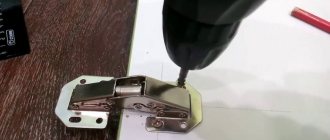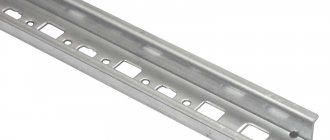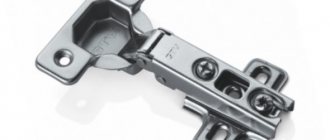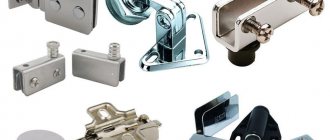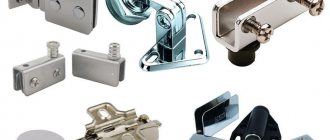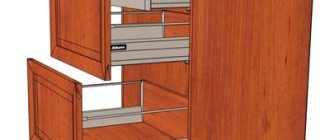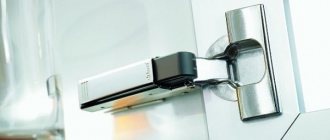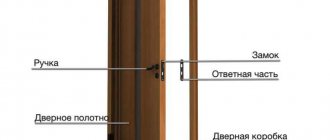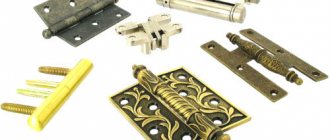Piano hinges: where to use and how to install?
Piano hinges (also called card hinges) are a single-hinged multi-tubular mechanism consisting of two plates:
- one of which is attached to the inside of the facade (both with and without grooves),
- the second - on the end of the side wall of the furniture body.
In furniture production, piano-type hinges are usually used as hidden fasteners, as well as for heavy loads on doors (facades). Since it is attached along the entire length of the end, it therefore holds the entire door better.
Such hinges are usually used in kitchen cabinets, bedside tables, corners and ottomans with a top-opening seat. You will also see them in corner wardrobes (one door has a sliding system, and the second one has piano-type hinges).
magnetic holders are also installed for proper operation of vertically located doors . Since, unlike standard four-hinged furniture hinges, card hinges do not have springs, without a magnet they will not fit tightly to the body.
The main advantages of card loops are:
- Ability to withstand heavy weight of the facade,
- Providing additional rigidity,
- Inexpensive price,
- Almost invisible fastener.
In addition to the advantages, card loops also have disadvantages:
- There is no possibility of adjusting the facade (completely),
- Inconvenient installation
- Furniture using such hinges is a bit reminiscent of outdated, “grandmother’s”
HANGING DOORS
After installing the ties, all that remains is to attach the plinth, hang the doors and
insert the box into the niche. The first and last of these operations do not require
explanations, but more details should be said about the doors.
To hang the doors you need to purchase hinges, preferably piano hinges
Such hinges are suitable for any piece of furniture, regardless of
door heights. They are relatively cheap, very easy to install and
extremely reliable. In addition, they serve as a kind of decoration. IN
Loops with lengths of 500, 1000 mm and more are available for sale. You need to cut
hinges of such a length that is exactly equal to the height of the door. Do it
easy with a hacksaw.
Don't throw away any short loop scraps. They may be useful for others
pieces of furniture. The fact is that the door does not have to be hung with
using a solid loop. The loop can be made up of separate, closed
closely, along no interconnected parts (). If
sawed off loop, the first hole for the screw turned out to be too far from
end (more than 45 mm), then for better pressing of the attached loop
It is advisable to drill an additional hole at a distance of 15 mm from the end
and countersink it.
To hang the door using a piano hinge, just attach
loop one turning strip to the door, the other to the side wall. If
the door is insertable (located between the walls), as in your case, a hinge
must be attached to the edge of the door (). If the door is overhead
(hangs over the walls), you need to attach the loop to the inner plate
doors (). For inset doors, the hinges are attached first to
walls, with overhead ones - to the doors.
The hinge should be fastened so that its hinge is flush with the edge of the wall.
To attach the hinges, use small 2.5X15 or 3X15 screws. Screws
can be placed not in every hole, but through one, but at the ends of the loop
screws are a must.
Before connecting the hinges to the doors themselves, it is necessary to
checking and, if necessary, adjusting the doors. To do this, place the table on the back
wall and, using a temporary lining, insert the doors into place
If both doors fit freely and there is no gap between them
exceeds 1 mm, no adjustment is necessary. Can be hung immediately
doors. If the doors are wider and one door bumps into another,
it is necessary to make bevels, or, as they say, chamfer the sash
door edges (). Usually the bevel is made at the left door outwards, and at
with the right one - inward, so that the right door overlaps the left one. Bevel size
taken equal to 3 - 5 mm. Sometimes you can limit yourself to chamfering only
on one right door. To remove a chamfer, you need to cut a deep hole with an awl.
mark on its border (parallel to the edge) and then trim off the excess
wood first with sherhebel and then with a plane.
If there is too much of a gap between the doors, it means the doors
tapered. You will have to nail it to the side edge of one of the doors with small
nail the strip of the required thickness and hide the seam when finishing. In general, in
To avoid mistakes, it is advisable to cut one of the doors to width and
plan not in advance, but only during a trial assembly, when
Types of fittings
Depending on what is supposed to be closed - a room, an apartment, a closet, a bathhouse, as well as on the material and size of the sash, the appropriate fittings are selected. There are a lot of options here:
- overhead - have the simplest design, in fact, these are ordinary card loops, quite thin and durable. The main feature is that you can attach them both to cabinet doors and to interior doors without inserting them. Typical representatives are piano bars, for example, used for installation on furniture doors, or butterflies. The butterfly is of the one-piece type, which makes installation somewhat difficult;
Installing piano hinges - how to do it right
High-quality and durable operation of furniture lies in several factors, not the least of which is good fittings, namely hinges for furniture doors. One of the best options for installing furniture on doors is a piano hinge - this fitting has already gained high popularity and demand among home craftsmen, so it is recommended that you install it too. If you have made a choice in favor of installing piano hinges, the following guide will help you understand such a simple but important matter as installing piano hinges, their choice and certain features that you should know about before choosing.
How to choose the right furniture hinges
Many manufacturers of furniture hinges produce low-quality fittings because they want to save on production. To purchase a quality product, it is worth looking at the thickness of the metal. If it is thin, it is better to refuse the purchase. It is worth paying attention to the price equivalent - it is better not to purchase cheap accessories. The number of items depends on the size of the façade and its weight. The hinges must be durable; this determines how long they can last.
How to properly install hinges on a cabinet - installation, proper adjustment and alignment
How to install hinges on a cabinet: instructions and recommendations |
Furniture assembly usually ends with hanging the doors, so it is important to know how to install hinges on the cabinet. The lifespan of the product and its appearance depend on how well this is done. There are various types of hinges on the hardware market. Each of them has its own characteristics. To understand the technique of installing hinges, you first need to understand the differences between each type of fastener.
Varieties and sizes
There are many options where to buy such accessories wholesale or retail. You can go around specialized stores, go to Leroy Merlin, Obi in Moscow, St. Petersburg and other cities, visit online trading platforms, contact leading manufacturers of furniture fittings.
But before you buy piano hinges, you need to determine the appropriate sizes and types, understand what width, height, thickness is required, and what will best fit specifically into the design of your furniture.
The height of grand pianos can vary from 100 to 3500 millimeters, and the pitch is usually 15 millimeters. The thickness of the hinges is up to 1.5 millimeters, and the width ranges from 20 to 40 millimeters. Also pay attention to the rotation angle of 90 degrees.
It happens that the length of a hinge does not fit a particular piece of furniture or façade. In this case, you can trim the product a little with your own hands. Not the façade, but the loop itself.
How to install
Often, piano hinges are used for hidden fastening of a kitchen cabinet door, a sofa seat, an ottoman or bedside table, or a book-table. Installation does not require special knowledge, skills or equipment. You need a hinge element of the appropriate size, an awl, a screwdriver, a drill or a screwdriver. The required number of screws or self-tapping screws. To begin with, the piano hinge is attached to the inside of the facade using a self-tapping screw. Next, the resulting structure is screwed to the end of the body. After this, screws are screwed in on the opposite side of the facade and along its entire length.
If the door is not an overhead door, but an internal one, then first the element is attached to the end of the facade, and then to the inside of the body. It is necessary to check whether the part is installed correctly and how it opens. Then screw the remaining screws on the body. To ensure that the mechanism works well and does not creak, you can lubricate it with machine oil or treat it with a special aerosol.
Selection of piano hinges by material
They are available in a wide range of materials and finishes such as steel, A2, A4 stainless steel, galvanized, nickel and brass plated steel, aluminium, solid brass, ensuring their versatility for a wide range of applications across all manufacturing sectors.
- Steel:
Has the greatest strength, moderate cost, but is not resistant to corrosion in unstable conditions. The best application for steel hinges is in a controlled environment, such as inside buildings, where temperature and humidity are maintained at normal levels. - Stainless Steel:
Also has great strength and in addition, it is resistant to rust in humid environments and outdoors. Stainless steel piano hinges are hygienic, which allows them to be used in medical and food equipment. They also come in a beautiful satin finish or high-gloss polish. - Brass:
does not corrode, is resistant to oxidation and is very decorative. However, it has less strength than steel and stainless steel. - Aluminum:
a lightweight metal with high anti-corrosion properties. Aluminum hinges are characterized by aesthetics and low cost, but under high loads they can bend, which is why they are not suitable for use in heavy door structures.
Where else is it used?
Furniture fittings perform not only operational functions, but often also serve as decoration. Most modern components have beautiful finishes and good design. Therefore, piano hinges often act as decorations. In the construction sector, this includes not only furniture, but also the production of screens and light partitions for small apartments. Regarding musical instruments (except grand piano and upright piano) - cases for other instruments and props.
In higher education institutions and schools - boards, teaching aids, advertising structures. These are all kinds of boxes, cases for collections, museum display cases, display cabinets, chess sets. A piano hinge (small sizes, for example) opens and closes cases for many precision instruments, such as binoculars, microscopes, spectrometers. Church utensils are also equipped with a similar mechanism: folding icons, frames and much more.
Advantages and disadvantages
Today, hidden fasteners can be made using many modern mechanisms. Despite the fact that the piano loop came to us from the distant past, it has not lost popularity to this day. Able to withstand the weight of large and heavy facade structures. Due to its length and the number of mounting holes, the hinge can add additional rigidity to the façade.
After assembly it is almost invisible. In addition, it has a reasonable price. If necessary, the fasteners can always be replaced with new ones. There is no shortage of such products. It is easy and simple to use when making furniture yourself or for connecting and mounting several furniture structures.
The disadvantages include the fact that the finished product does not have the ability to adjust the front part. The mechanism does not have a locking spring. To ensure that the door fits tightly and does not open, it is recommended to install magnetic latches. Installation is not entirely convenient and requires manual precise alignment of one part in relation to another. The appearance of the finished furniture is somewhat reminiscent of retro models.
